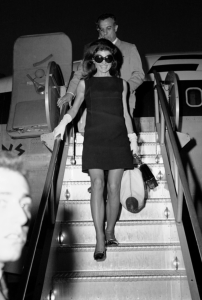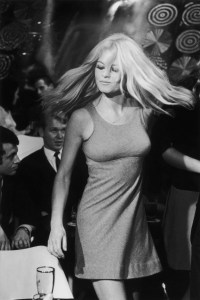If you purchase an independently reviewed product or service through a link on our website, WWD may receive an affiliate commission.
In this article
Every few decades we collectively ready ourselves for the return of the “Little Nothing Dress”, consciously or not. Right now, we’re all tired of all of those super feminine sundresses that felt like such a good idea when we bought them.
The little nothing was born out of fatigue with the prim and oppressive looks of the 1950s. In her article the “Ultimate Little Black Dress,” late British fashion journalist Meredith Etherington-Smith sets the scene for arguably the most iconic little nothing, Holly Golightly’s. “The opening scene of Breakfast At Tiffany’s, featuring Audrey Hepburn walking along having breakfast in her night-before iconic little black dress is one of the great fashion moments in cinema history. Givenchy’s inspiration for the dress has its roots in another iconic fashion moment, more than forty years before,” she says. “His was in 1925 when Chanel produced a collection of boyish ‘garconne’ dresses, many of which were black. These drew the comment from Harper’s Bazaar at the time that Chanel had created ‘the little black dress, the Ford motor car of the season.”
You can almost picture Holly saying “oh what? this little nothing” as she exits the powder room to much sartorial praise for her easy LBD. And yes, the little nothing also recalls the 1920s, a time when women were reclaiming their freedom through simple styles that moved with them and never against them. Nothing says power like stripping down to the chicest, bare minimum.

Courtesy of Harry Morrison
Jackie Kennedy Onassis arriving at JFK after a weekend in Skorpios, Greece in 1969.
The timing of the 1960s and all of the social and political upheaval it would bring makes perfect sense for the rise of the little nothing. It’s not exactly counterculture, but it’s a move towards the casual, of inching into feminine liberation and the sexual revolution. It tracks with Mary Quant’s mini skirt. Designer Main Rousseau Bocher, also known as Mainbocher, is known to have invented both the strapless dress and the sheath, making him a grandfather of the little nothing. “I think I’ve been a reassuring influence in fashion,” he once said. “I don’t want my clothes to make a woman look desperate for attention; I do want them to add to her chic and not make her look smarty smart.”
Of course, Jackie Kennedy is the raison d’etre to the sheath, the fairy godmother of effortlessly beautiful style. All of those little pastel dresses and pillbox hats may seem fussy to us now, but then, it was a revelation of ease. In her book “Fashion Identity,” Maria Mackinney-Valentin perfectly sums up the vibe check of the little nothing in the 1960s. “It was heralded for its uncluttered look,” she writes, “for those who were wealthy enough to demonstrate that they did not have to put in too much effort, who hate to seem that they’ve tried too hard.”
Today’s reigning poster girl for the little nothing is Kendall Jenner. Her off duty Haute Couture looks earlier this month caused a stir, and while her kicky Alaïa frock and form-fitting gray Bottega Veneta dress also served as beacons of pared back simplicity, it was a reasonably-priced gray tank dress from Aussie label St. Agni Studio that was covered ad nauseam on the style beat. Part of the hooplah was that the dress recalled an iconic moment in Sex in the City wardrobe history. Carrie Bradshaw wore a similar look in charcoal gray in season two, episode 15, “Shortcomings,” the ideal title for that ultra-mini cotton dress that paired so perfectly with aviators and strappy sandals.

Courtesy of HBO
Sarah Jessica Parker’s Carrie Bradshaw wears a slate gray dress in a 1999 episode of Sex and the City.
Much like the 1960s, the 1990s were a move away from the often constraining, exaggerated, and yes, glamorous styles of the decade that preceded it. While Bradshaw was hardly a minimalist, this little nothing certainly is and it challenges the idea that glamour has to mean glitz and volume. Designer Anna Sui embodied that mood in 1997. “I finally went on a vacation to St. Bart’s, and I started thinking about very beautiful beach clothes — lots of little dresses, my idea of summer evening clothes,” she’s quoted as saying. “Then I saw this Brigitte Bardot movie, “A Private Affair,” where she wears a little-nothing dress and a big hat.” It’s a full circle 1960s to 1990s parallel, where a moment of purity is what stops a fashion-lover mid-sentence. It should come as little surprise that the New York Times published an op-ed entitled “The Return of the Little Nothing Dress” in 1991.

French actress and sex symbol Brigitte Bardot stage name of Camille Javal, dancing in a scene from the film ‘Two Weeks In September’ with Mike Sarne.
Photo by Reg Lancaster/Getty Images
While we’re reluctant to bring up that overwrought buzzword quiet luxury, it is the overarching style moment of the year and we’d concede the little nothing fits snugly under its umbrella. Quiet luxury is the 2020s equivalent to 1990s minimalism after all. No one was buying their restrained shifts from just anyone; they came from Calvin Klein and Prada.
The little nothing now is most often found from Aussie brands like Jenner’s go-to St. Agni Studio, as well as Bec + Bridge. These dresses are also available from minimalist mainstays like The Row, Toteme, and Khaite. It doesn’t need to be a quote-unquote “Quiet luxury” brand, and it doesn’t need to be a particular length, but it has to be subtle in color and lean in fit. The little nothing is all about an attitude. It’s the opposite of try-hard. It’s the dress that makes people on the street wonder, “who even is she?”

Naomi Campbell walks the runway for Michael Kors’ 1994 Ready-to-Wear collection.
Courtesy of Penske Media
Sign up for WWD Shop’s newsletter to get the scoop on the best in beauty and style with in-depth reviews of exciting new releases and buyer’s guides to find the products you need to try ASAP.
Related:
Best Summer Dresses
Best Slip Dresses
Best Fall Dresses
Shop the Best Little Nothing Dresses
Meet the Author
Kerry Pieri is a multi-hyphenate creative: fashion editor, brand consultant, author, and more. Pieri served as the digital fashion and features director at Harper’s BAZAAR for ten years, and she continues to write for publications including Eyeswoon, L’Officiel, and Porter Magazine. She has worked within the fashion and editorial industries for fifteen years. Learn more about WWD here.
This post was originally published on this site be sure to check out more of their content.








